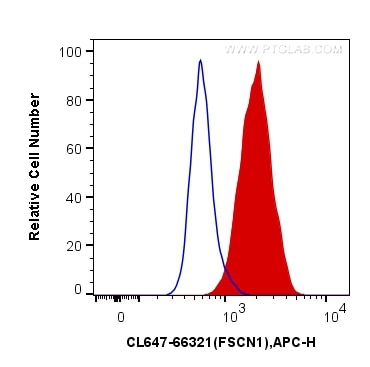Fascin Monoklonaler Antikörper
Fascin Monoklonal Antikörper für FC (Intra)
Wirt / Isotyp
Maus / IgG2a
Getestete Reaktivität
human
Anwendung
FC (Intra)
Konjugation
CoraLite® Plus 647 Fluorescent Dye
CloneNo.
1B5G3
Kat-Nr. : CL647-66321
Synonyme
Galerie der Validierungsdaten
Geprüfte Anwendungen
| Erfolgreiche Detektion in FC | HeLa-Zellen |
Empfohlene Verdünnung
| Anwendung | Verdünnung |
|---|---|
| Sample-dependent, check data in validation data gallery | |
Produktinformation
CL647-66321 bindet in FC (Intra) Fascin und zeigt Reaktivität mit human
| Getestete Reaktivität | human |
| Wirt / Isotyp | Maus / IgG2a |
| Klonalität | Monoklonal |
| Typ | Antikörper |
| Immunogen | Fascin fusion protein Ag6074 |
| Vollständiger Name | fascin homolog 1, actin-bundling protein (Strongylocentrotus purpuratus) |
| Berechnetes Molekulargewicht | 55 kDa |
| Beobachtetes Molekulargewicht | 55 kDa |
| GenBank-Zugangsnummer | BC000521 |
| Gene symbol | FSCN1 |
| Gene ID (NCBI) | 6624 |
| Konjugation | CoraLite® Plus 647 Fluorescent Dye |
| Excitation/Emission maxima wavelengths | 654 nm / 674 nm |
| Form | Liquid |
| Reinigungsmethode | Protein-A-Reinigung |
| Lagerungspuffer | BS mit 50% Glyzerin, 0,05% Proclin300, 0,5% BSA, pH 7,3. |
| Lagerungsbedingungen | Bei -20°C lagern. Vor Licht schützen. Aliquotieren ist bei -20oC Lagerung nicht notwendig. 20ul Größen enthalten 0,1% BSA. |
Hintergrundinformationen
Fascin is a highly conserved and ubiquitous actin cross-linking protein that has a major function in cell motility and adhesion. Fascin localizes to a number of highly dynamic cellular structures that require strong mechanical support which include stress fibers and cellular protrusions such as microvilli, microspikes and lamellipodia. Fascin is up-regulated in many human carcinomas. It's a marker for Reed-Sternberg cells in Hodgkin's disease; it is also a highly selective marker for dendritic cells of lymphoid tissues.
Protokolle
| Produktspezifische Protokolle | |
|---|---|
| FC protocol for CL Plus 647 Fascin antibody CL647-66321 | Protokoll herunterladen |
| Standard-Protokolle | |
|---|---|
| Klicken Sie hier, um unsere Standardprotokolle anzuzeigen |



